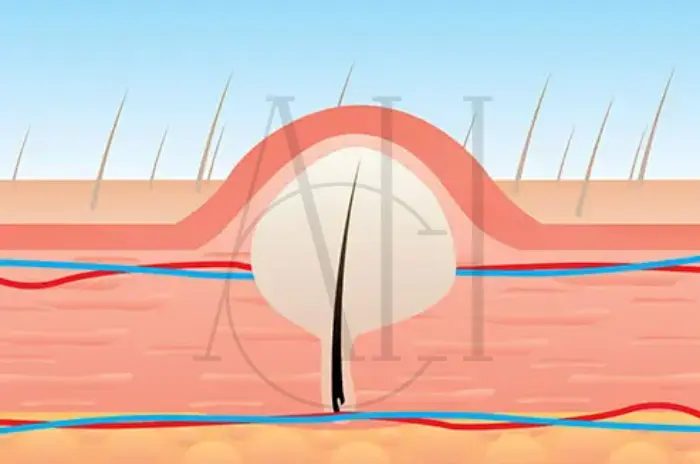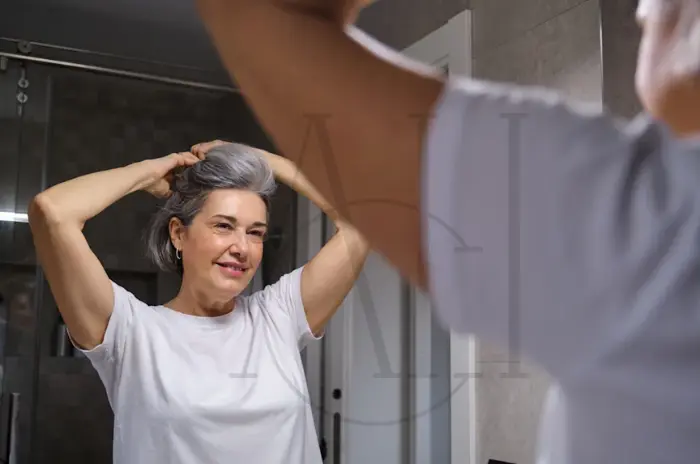When you notice bumps or lesions in sensitive areas after hair removal, it’s natural to feel concerned. Understanding the difference between ingrown hair and herpes symptoms is crucial for proper treatment and peace of mind. While both conditions can cause discomfort and similar-looking bumps, they have distinct characteristics, causes, and treatment approaches.
Ingrown hair occurs when hair grows back into the skin instead of rising up from it, creating bumps that can be mistaken for other conditions. Herpes outbreaks, caused by the herpes simplex virus (HSV), produce painful blisters that can appear in similar locations. Knowing how to distinguish between these conditions helps you seek appropriate care and avoid unnecessary anxiety.
Table of Contents
ToggleWhat Is an Ingrown Hair?
An ingrown hair develops when a hair follicle becomes trapped beneath the skin’s surface instead of growing outward normally. This common condition typically occurs after hair removal methods like shaving, waxing, or plucking. The trapped hair creates inflammation and can lead to ingrown hair bumps that may appear red, raised, and sometimes filled with pus.
Ingrown hair symptoms include small, round bumps that may be tender to touch. These bumps often develop a day or two after hair removal and can affect anyone who removes body hair. The condition is particularly common in areas where hair is coarse and curly, as these hair types are more likely to curl back into the skin.
How Ingrown Hair Forms and Heals
The formation of ingrown hair begins when the hair shaft curves and grows sideways or downward into the skin. This typically happens when the hair opening becomes blocked by dead skin cells or when the hair is cut at a sharp angle during shaving. The body recognizes the trapped hair as a foreign object, triggering an inflammatory response.
Folliculitis vs herpes confusion often arises because both conditions can cause similar-looking red bumps. However, ingrown hair infection usually remains localized to individual hair follicles and doesn’t spread from person to person. The healing process typically takes one to two weeks as the body naturally pushes the hair to the surface or absorbs it.
Common Locations After Shaving or Waxing
Ingrown hair bumps most commonly appear in areas where hair removal is frequent and the hair is coarse. The bikini line, legs, underarms, and face are typical locations for men and women. In men, razor bumps vs herpes confusion often occurs on the neck and jawline where daily shaving creates ideal conditions for ingrown hairs.
Areas with tight clothing or frequent friction are particularly susceptible to developing ingrown hair problems. The pubic region is especially prone due to the curly nature of pubic hair and frequent removal practices. Understanding these common locations helps differentiate between STD or ingrown hair concerns when bumps appear in intimate areas.
What Is Herpes?
Herpes is a viral infection caused by the herpes simplex virus (HSV), which exists in two main types: HSV-1 and HSV-2. While HSV-1 traditionally causes oral herpes and HSV-2 causes genital herpes, both types can infect either location. Unlike ingrown hair, herpes is a sexually transmitted infection that creates characteristic herpes blisters and sores.
Herpes symptoms include painful, fluid-filled blisters that typically appear in clusters. These herpes bumps vs ingrown hairs have distinct characteristics that help differentiate them from hair-related issues. The virus remains dormant in the body after initial infection and can reactivate periodically, causing recurring herpes outbreaks.
What Causes Herpes and How It Spreads
Herpes simplex virus (HSV) spreads through direct skin-to-skin contact during sexual activity, kissing, or other intimate contact. The virus enters the body through small breaks in the skin or mucous membranes. Once infected, the virus travels to nerve cells where it remains dormant between outbreaks.
Unlike ingrown hair, which is not contagious, herpes can be transmitted even when no visible symptoms are present. This is called asymptomatic shedding, making herpes testing important for sexually active individuals. The virus cannot be cured, but antiviral medications can manage symptoms and reduce transmission risk.
Stages of a Herpes Outbreak
Herpes outbreaks typically follow a predictable pattern. The prodrome stage involves tingling, burning, or itching sensations before visible symptoms appear. This is followed by the appearance of herpes blisters that are initially clear and fluid-filled, unlike the solid bumps of ingrown hair.
The blisters then burst, creating painful open sores that crust over and heal within 7-10 days. During this time, the lesions are highly contagious. This cyclical pattern helps distinguish herpes vs folliculitis since ingrown hairs don’t follow this specific progression.
Ingrown Hair vs Herpes: Key Differences
Understanding the distinctions between ingrown hair and herpes symptoms is essential for proper identification and treatment. These conditions affect different people for different reasons and require entirely different approaches to management and prevention.
The most significant difference lies in their contagious nature. Ingrown hair is not transmissible between people, while herpes is a sexually transmitted infection. This fundamental difference affects not only treatment but also the implications for sexual health and partner notification.
| Characteristic | Ingrown Hair | Herpes |
|---|---|---|
| Appearance | Solid, raised bumps with possible pus | Fluid-filled blisters in clusters |
| Pattern | Individual, scattered bumps | Clustered lesions in localized area |
| Pain Level | Mild tenderness or itching | Significant pain and burning |
| Contagious | Not contagious | Highly contagious during outbreaks |
| Healing Time | 1-2 weeks | 7-10 days per outbreak |
| Recurrence | Only with continued hair removal | Lifelong recurring outbreaks |
| Systemic Symptoms | None | Fever, swollen lymph nodes |
| Causes | Hair growing back into skin | Herpes simplex virus (HSV) |
| Treatment | Exfoliation, topical treatments | Antiviral medications |
| Long-term Effects | Possible scarring if infected | Chronic condition requiring management |
Appearance of Bumps vs Blisters
Ingrown hair bumps typically appear as solid, raised bumps that may contain pus. They often have a visible hair in the center or a dark spot where the hair is trapped. These bumps are usually isolated and don’t occur in clusters.
Herpes blisters, in contrast, begin as fluid-filled vesicles that appear in groups. They have a characteristic appearance with a red base and clear fluid content. When comparing fluid filled bump vs blister, herpes lesions are typically more fragile and burst easily, while ingrown hair bumps remain solid unless infected.
Single vs Clustered Lesions
Ingrown hair typically presents as individual bumps scattered across the affected area. Each bump corresponds to a single hair follicle and develops independently. You might see several bumps after shaving, but they don’t cluster together in one specific spot.
Herpes outbreaks characteristically appear in clusters of blisters in a localized area. These clusters can contain anywhere from a few to dozens of small blisters grouped closely together. This clustering pattern is one of the most reliable ways to distinguish between herpes bumps vs ingrown hairs.
How Long They Last and Heal
Ingrown hair typically resolves within one to two weeks. The bump may persist longer if the hair remains trapped, but most cases heal naturally as the hair works its way to the surface or is absorbed by the body. Proper care can speed healing and prevent complications.
Herpes outbreaks follow a more predictable timeline. Initial outbreaks last 7-10 days, while recurrent episodes may be shorter. The healing process involves distinct stages from blister formation to crusting and complete healing. Antiviral medications can reduce outbreak duration and severity.
Contagious vs Non-Contagious Conditions
Ingrown hair is completely non-contagious. You cannot transmit or receive ingrown hairs from another person through any type of contact. This condition is purely mechanical, resulting from hair growth patterns and removal practices.
Herpes, however, is highly contagious during active outbreaks and can be transmitted even when no symptoms are visible. Understanding this difference is crucial when determining whether you’re dealing with STD or ingrown hair situations that might require partner notification and testing.

Long-Term Effects of Ingrown Hair and Herpes
Both conditions can have lasting effects if not properly managed, though the nature of these effects differs significantly. Understanding potential complications helps guide treatment decisions and preventive measures.
Ingrown hair complications are generally cosmetic or localized, while herpes has broader implications for sexual health and requires ongoing management as a chronic condition.
Scarring and Recurrent Bumps from Ingrown Hair
Chronic ingrown hair can lead to permanent scarring, especially if bumps are frequently picked or improperly treated. Dark spots, known as post-inflammatory hyperpigmentation, commonly develop in areas prone to ingrown hairs. These marks can take months to fade and may require dermatological treatment.
Ingrown hair infection can occur when bacteria enter damaged follicles, potentially leading to more serious complications like cellulitis. Proper hair removal techniques and skincare can prevent most long-term effects and maintain healthy skin in affected areas.
Managing Recurring Herpes Outbreaks
Herpes outbreaks tend to become less frequent and severe over time, but the virus remains in the body permanently. Many people experience several outbreaks in the first year after infection, with frequency typically decreasing afterward. Stress, illness, and hormonal changes can trigger recurrences.
Long-term management includes antiviral medications to suppress outbreaks and reduce transmission risk. Regular herpes testing helps monitor the condition and ensures appropriate treatment adjustments. Unlike ingrown hair, herpes requires ongoing medical management and lifestyle considerations.
Prevention Tips for Both Conditions
Preventing both ingrown hair and herpes requires different strategies, but both involve good hygiene and careful attention to affected areas. Understanding prevention methods helps reduce the frequency and severity of both conditions.
While ingrown hair prevention focuses on proper hair removal techniques, herpes prevention centers on safe sexual practices and antiviral therapy when appropriate.
How to Reduce Ingrown Hair After Hair Removal
Preventing ingrown hair starts with proper hair removal techniques. Use sharp, clean razors and shave in the direction of hair growth. Exfoliate regularly to remove dead skin cells that can block hair follicles. Avoid tight clothing immediately after hair removal to reduce friction and irritation.
Razor bumps vs herpes confusion can be minimized by maintaining good shaving practices. Use lubricating shave gel, avoid dry shaving, and consider alternative hair removal methods if you’re prone to ingrown hair bumps. Electric clippers that don’t cut hair below skin level can reduce ingrown hair risk.
How to Prevent Herpes Transmission
Herpes prevention requires consistent safe sexual practices, including using condoms and dental dams during all sexual activities. However, these barriers don’t provide complete protection since herpes can spread through skin-to-skin contact in areas not covered by protection.
Open communication with sexual partners about herpes symptoms and testing status is essential. Antiviral suppressive therapy can significantly reduce transmission risk for people with herpes. Regular STD or ingrown hair evaluations help ensure early detection and proper treatment of any concerning symptoms.
What Are the Symptoms of Herpes?
Herpes symptoms can vary significantly between individuals and outbreak episodes. Initial infections often produce more severe symptoms than recurrent outbreaks, and some people may experience very mild symptoms that go unnoticed.
The location and severity of herpes symptoms depend on the virus type and individual immune response. Understanding these symptoms helps distinguish herpes from other conditions like ingrown hair.
Painful Sores or Blisters in Genital Area
Herpes blisters typically begin as small, fluid-filled vesicles that appear in clusters on or around the genitals, anus, or mouth. These blisters are often preceded by tingling, burning, or itching sensations in the affected area. The blisters eventually burst, creating painful open sores.
The pain associated with herpes outbreaks is typically more intense than discomfort from ingrown hair bumps. The sores may make urination painful and can significantly impact daily activities. This level of pain is a key distinguishing factor when comparing painful ingrown hair vs herpes.
Tingling, Burning, Fever, and Swollen Lymph Nodes
Herpes symptoms often include systemic signs like fever, headache, and muscle aches, especially during initial outbreaks. Swollen lymph nodes in the groin, neck, or underarms are common and indicate the body’s immune response to the viral infection.
The tingling or burning sensation that precedes visible herpes blisters is called prodrome and can help people recognize incoming outbreaks. These warning signs don’t occur with ingrown hair, making them valuable diagnostic clues when differentiating between the conditions.
What Are the Symptoms of Ingrown Hair (Folliculitis)?
Ingrown hair symptoms are typically localized to the affected hair follicles and don’t cause systemic illness. These symptoms usually develop within 24-48 hours after hair removal and can persist until the hair is released or the bump resolves.
Understanding folliculitis vs herpes symptoms helps avoid unnecessary concern and ensures appropriate treatment. Most ingrown hair symptoms can be managed with proper home care and preventive measures.
Red, Fluid-Filled Bumps Around Hair Follicles
Ingrown hair bumps appear as small, red, raised lesions centered around hair follicles. These bumps may contain pus or clear fluid, but unlike herpes blisters, they typically remain intact and don’t burst spontaneously. You may see a dark hair loop or spot in the center of the bump.
The bumps from ingrown hair are usually uniform in size and appearance, while herpes bumps vs ingrown hairs show that herpes lesions vary more in size and shape within the same outbreak. Ingrown hair bumps also tend to be more isolated rather than clustered.
Itching, Soreness, and Possible White Pus
Ingrown hair symptoms include mild to moderate itching and tenderness in the affected area. The bumps may become sore to touch, especially if they become infected. Itchy red bumps after shaving are a common complaint that usually indicates ingrown hairs rather than a more serious condition.
When ingrown hair infection occurs, the bumps may develop white or yellow pus and become more painful. This secondary bacterial infection requires different treatment than simple ingrown hairs but still doesn’t pose the same health implications as herpes symptoms.

Causes: Why Ingrown Hair and Herpes Occur
Understanding the underlying causes of both conditions helps with prevention and treatment decisions. While ingrown hair results from mechanical factors related to hair growth and removal, herpes is caused by viral infection.
The causes of these conditions are completely different, which explains why their treatments and long-term management strategies vary significantly.
What Causes Ingrown Hairs?
Ingrown hair occurs when hair follicles become blocked by dead skin cells, oil, or debris, forcing the hair to grow sideways or curl back into the skin. This is more common with curly or coarse hair that naturally tends to curve as it grows.
Poor shaving techniques contribute significantly to ingrown hair development. Shaving against the grain, using dull razors, or dry shaving can create sharp hair edges that easily penetrate the skin. Shaving bumps vs herpes concerns often arise when people don’t realize that their hair removal practices are causing mechanical irritation.
What Triggers Herpes Outbreaks?
Herpes outbreaks are triggered by various factors that weaken the immune system or create stress on the body. Common triggers include physical or emotional stress, illness, fatigue, hormonal changes, and sun exposure. Some people can identify specific triggers while others experience seemingly random outbreaks.
Unlike ingrown hair, which is directly related to hair removal practices, herpes triggers are often internal factors. Understanding these triggers helps people with herpes develop strategies to reduce outbreak frequency and severity through lifestyle modifications and medical management.
Testing and Diagnosis
Proper diagnosis is essential for distinguishing between ingrown hair and herpes symptoms, especially when bumps appear in genital areas. While ingrown hair can usually be diagnosed through visual examination, herpes may require laboratory testing for confirmation.
Understanding when to seek medical evaluation helps ensure appropriate treatment and prevents unnecessary anxiety about STD or ingrown hair concerns.
When to Consider an STD Test
Herpes testing should be considered when bumps appear in genital areas, especially if accompanied by systemic symptoms like fever or swollen lymph nodes. Anyone with new sexual partners or those experiencing their first episode of concerning genital bumps should seek medical evaluation.
STD or ingrown hair determination becomes important when bumps are painful, appear in clusters, or are accompanied by flu-like symptoms. Healthcare providers can perform visual examinations and order appropriate tests to distinguish between these conditions.
At-Home Herpes Testing Options
Several at-home herpes testing options are available, including blood tests that detect antibodies to HSV-1 and HSV-2. These tests can identify past or current infections even when no symptoms are present. However, they cannot distinguish between herpes vs folliculitis during active symptoms.
While convenient, at-home tests have limitations and may require follow-up with healthcare providers for interpretation and treatment recommendations. Professional medical evaluation remains the gold standard for diagnosing herpes symptoms and ruling out other conditions.
How Doctors Diagnose Ingrown Hairs
Ingrown hair diagnosis typically involves visual examination of the affected area. Doctors look for characteristic signs like trapped hairs, isolated bumps, and the absence of systemic symptoms. The location and timing relative to hair removal activities provide additional diagnostic clues.
When ingrown hair infection is suspected, doctors may take cultures to identify bacterial involvement and guide antibiotic treatment. Unlike herpes diagnosis, ingrown hair evaluation rarely requires specialized laboratory testing.
Treatment Options for Ingrown Hair and Herpes
Treatment approaches for ingrown hair and herpes symptoms differ significantly due to their distinct causes. While ingrown hair treatment focuses on releasing trapped hairs and preventing infection, herpes treatment involves antiviral medications and symptom management.
Understanding appropriate treatments helps ensure effective management and prevents complications from either condition.
How to Treat and Prevent Ingrown Hairs
Ingrown hair treatment begins with gentle exfoliation to remove dead skin cells and help trapped hairs surface. Warm compresses can reduce inflammation and encourage hair release. Avoid picking or squeezing bumps, as this can lead to ingrown hair infection and scarring.
For persistent ingrown hair bumps, topical treatments containing salicylic acid or glycolic acid can help. Antibiotics may be necessary if bacterial infection develops. Ingrown hair prevention involves proper shaving techniques, regular exfoliation, and considering alternative hair removal methods for problem areas.
Medical Treatments for Herpes
Herpes treatment involves antiviral medications like acyclovir, valacyclovir, or famciclovir. These medications can reduce outbreak duration and severity when taken during active herpes symptoms. Daily suppressive therapy may be recommended for people with frequent outbreaks or to reduce transmission risk.
Pain relief for herpes blisters may include topical anesthetics and oral pain medications. Unlike ingrown hair treatment, herpes requires ongoing medical management and regular follow-up with healthcare providers to optimize treatment strategies.
Healing Time and Long-Term Effects
The healing timeline and long-term implications differ significantly between ingrown hair and herpes symptoms. Understanding these differences helps set appropriate expectations and guide treatment decisions.
While ingrown hair typically resolves completely with proper care, herpes is a chronic condition requiring ongoing management.
How Long Do Herpes Lesions Last?
Herpes outbreaks typically last 7-10 days from the first symptoms to complete healing. Initial outbreaks may last longer and be more severe than recurrent episodes. Antiviral treatment can reduce healing time by 1-2 days when started early in the outbreak.
The frequency of herpes outbreaks varies widely between individuals. Some people experience monthly episodes while others may go years between outbreaks. Most people find that outbreaks become less frequent and severe over time.
Ingrown Hair Healing Time and Scarring
Ingrown hair typically heals within 1-2 weeks with proper care. However, ingrown hair bumps that become infected or are repeatedly irritated may take longer to resolve. Picking or squeezing can extend healing time and increase scarring risk.
Ingrown hair scarring is more common in people with darker skin tones and can include both raised scars and dark spots. Professional treatments like chemical peels or laser therapy may be needed to address significant scarring from chronic ingrown hair problems.
Possible Complications of Each
Ingrown hair infection can lead to cellulitis, abscess formation, or permanent scarring. These complications are more likely when proper hygiene isn’t maintained or when bumps are repeatedly manipulated. Most complications can be prevented with appropriate care and early treatment.
Herpes complications can include secondary bacterial infections of lesions, urinary retention due to painful urination, and increased risk of acquiring other sexually transmitted infections. Rarely, herpes can cause serious complications like encephalitis, though this is extremely uncommon in healthy adults.
FAQ : Ingrown Hair vs Herpes Symptoms Causes and Treatment Options
What are the key visual differences between an ingrown hair and herpes?
Ingrown hair appears as solid, isolated bumps with possible visible hair or dark spots, while herpes blisters are fluid-filled vesicles that appear in clusters and eventually burst to form painful sores.
Where do ingrown hairs and herpes commonly appear on the body?
Ingrown hair bumps typically occur in areas where hair is removed like legs, bikini line, and face, while herpes symptoms appear on or around the genitals, anus, or mouth.
What are the main symptoms that differentiate herpes from an ingrown hair?
Herpes symptoms include painful clustered blisters, fever, and swollen lymph nodes, while ingrown hair symptoms involve isolated red bumps with mild itching and no systemic illness.
Is an ingrown hair contagious, and how does that compare to herpes?
Ingrown hair is completely non-contagious and cannot be transmitted between people, while herpes is highly contagious and spreads through skin-to-skin contact.
What causes ingrown hairs, and what triggers herpes outbreaks?
Ingrown hair is caused by hair growing back into the skin after removal, while herpes outbreaks are triggered by stress, illness, hormonal changes, or immune system weakness.
When should I seek medical attention for a suspicious bump, and how are they diagnosed?
Seek medical attention for bumps that are painful, clustered, or accompanied by fever; herpes testing may require laboratory confirmation while ingrown hair is usually diagnosed through visual examination.
How are ingrown hairs treated, and what are the medical treatments for herpes?
Ingrown hair treatment involves exfoliation, warm compresses, and topical acids, while herpes requires antiviral medications and may need daily suppressive therapy.
What are the long-term implications of having either an ingrown hair or herpes?
Ingrown hair may cause temporary scarring but resolves completely, while herpes is a chronic condition requiring lifelong management and consideration of transmission to partners.





